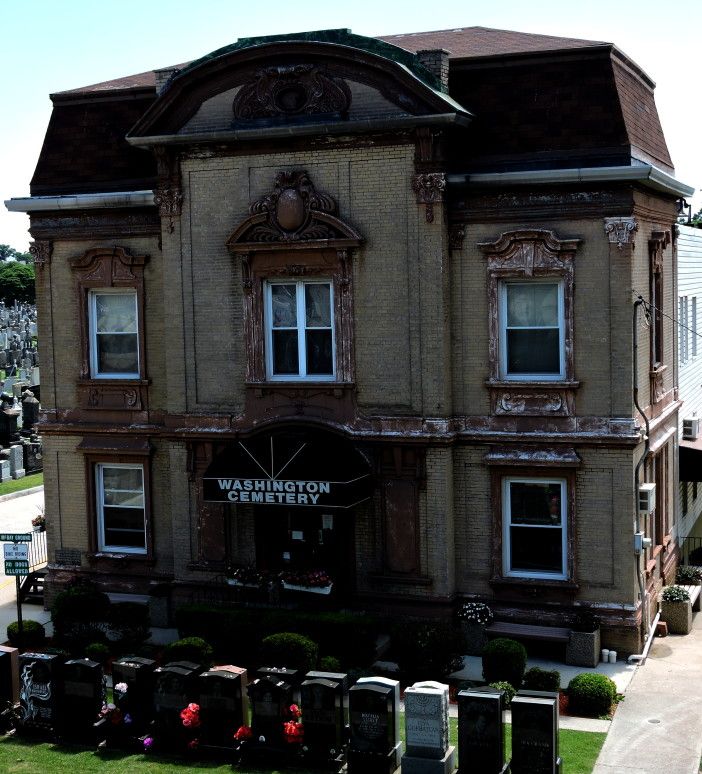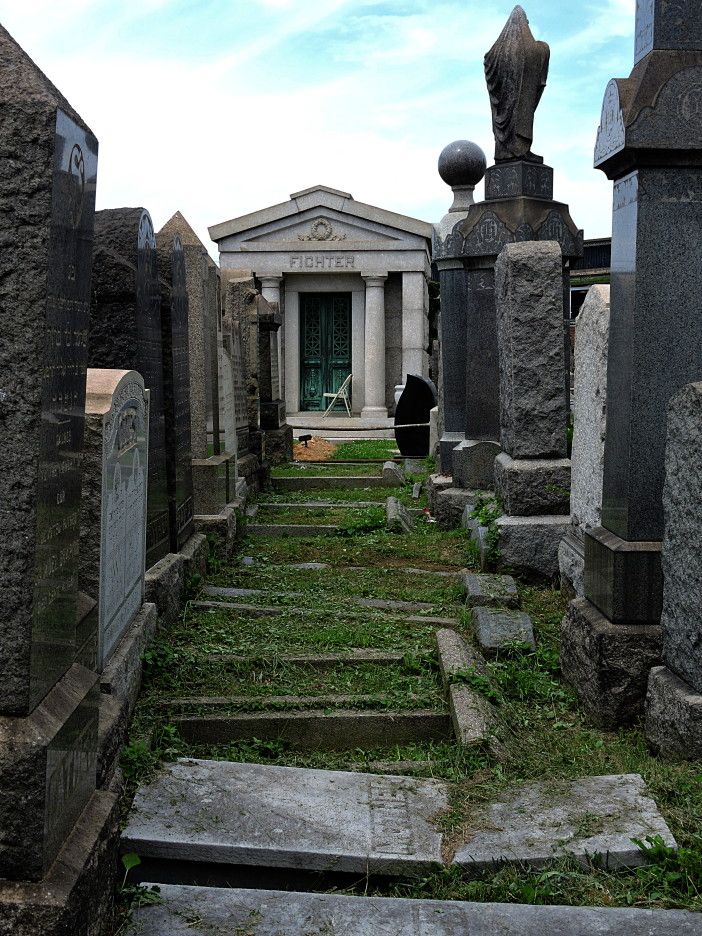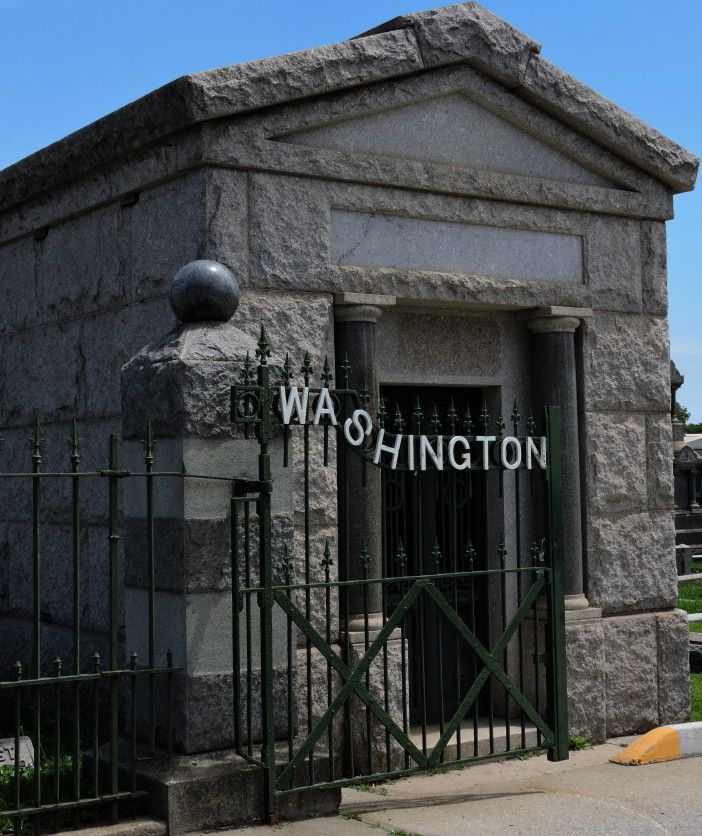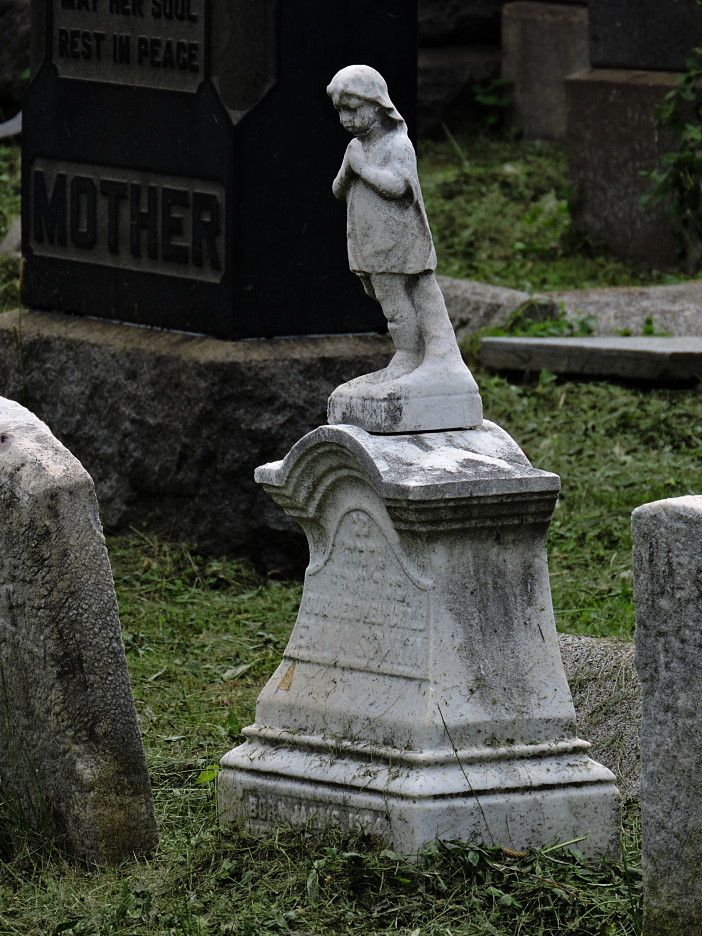Five Things You Probably Didn’t Know About Washington Cemetery


Like much of Bensonhurst, Washington Cemetery straddles the border between the ordinary and the absurd.
When first entering the cemetery, which pre-dates the Civil War, you’re surrounded with photo-realistic laser-etched faces on jet-black, smooth stones, which creates an oddly confrontational place of mourning. Add in some garish artificial flowers that adorn the obsidian monuments, and the scene is set for the next David Lynch film.
Washington Cemetery is at near capacity and is currently the densest burial ground in all of New York City. In the past 30 years or so, very few graves have been available, and those sold most often went to Eastern European immigrants. The difference in aesthetic value from the older, more modest, grave sites mirrors the evolution of the neighborhood.
Walking deeper through the narrow lanes, which are named for trees and other flora, one gets a brief sensation of time travel as the grave sites quickly jump to the early 20th and late 19th centuries, with many births in the 1700s. Washington Cemetery is today predominantly a Jewish burial ground and one of the only Jewish cemeteries in Brooklyn.

While it’s a little hard to speak cheerfully of a walk through a cemetery, the illuminating local history, along with the many butterflies and birds that have built homes there, make for a striking and interesting afternoon stroll. As with many parts of Bensonhurst, you’ll always get a little more than you first thought. Here are five more interesting anecdotes about Washington Cemetery you may not have known:
1. A Misprint and a Missed Chance
John Benet, the founder of Washington Cemetery and a Bensonhurst native, was the running-mate of Joseph Smith, Jr. in 1844. Smith was not just a presidential candidate, though. He was also the founding father of Mormonism.
Benet never did get to make early Bensonhurst proud as the neighborhood’s very own vice-president, because Joseph Smith, Jr. was assassinated before the election ever really took off.
To add insult to injury, Benet’s final resting spot is misspelled, with an extra final “T.”

2. Our Own Flapper
Lilyan Tashman was a Hollywood darling who was better known for her celebrity life than for her actual talent. Lilyan transitioned from silent movies to “talkies” and was well received for her glitzy image and rich voice.
Lilyan was a bit scandalous for her era, rumored to have had many open same-sex relationships. Also gossiped about was her marriage — widely considered to be a sham — to a man who was believed to be openly gay. Lilyan outdid herself with eccentricity, color coordinating everything in her home, down to the dark blue walls of her living room intended to contrast with her platinum blond hair.
Lilyan died at the young age of 37 from cancer. Lilyan’s funeral at Washington Cemetery was crashed by about 10,000 fans, all eager to get a glimpse (and a souvenir flower) before her final resting.
3. Laws of the Land
Washington Cemetery pre-dates the Civil War and was originally founded fairly quickly after the passing of the Rural Cemetery Act of 1847. This law allowed for the advent of private, commercialized cemeteries. Prior to this law, burial was only allowed on churchyards and privately owned land. At this point, Brooklyn and Queens were not officially part of New York City, and this law allowed for the opening of many cemeteries in both boroughs.
Washington cemetery was seen as quite affordable at the time and quickly filled up with the departed loved ones of the beginning influx of immigrants towards the end of 1800s.
This wasn’t the only time though where the law and Washington Cemetery met. Around 1899, a restaurant that had been operating on the grounds of the cemetery for a few years was shut down by the Department of Health.
4. Rolling Through The Graves
Washington Cemetery was one of the earliest stops on what was once called the Prospect Park and Coney Island Railroad — the present day F line. In 1886, for 30 cents, one could board the Prospect Park line once on the hour throughout the day and take it down Gravesend Avenue (today, McDonald Avenue) all the way to Coney Island, passing Washington Cemetery as the third to last stop.
Part of what made Washington Cemetery so appealing (besides being one of the more affordable burial grounds) was its ease of access by the new, popular railroads.
5. A Curious Cold Case

In 1901, Washington Cemetery was subject to a partial grave robbing. The remains of 8-year-old Rosie Foss were illegally exhumed and her head removed in a skillful fashion. While the case remains cold, Rosie’s mother and police believed the grave robbing was the result of morbidly curious and over-zealous medical students. When Rosie Foss passed away from complications due to pneumonia, a woman identified as “sister” (but not a nun, apparently) claimed that young Rosie had a “mental malady” and that the doctors wanted to perform an autopsy on her head, but Mrs. Foss refused. When the robbed grave was discovered, and Mrs. Foss gave her account to the police, authorities interviewed the hospital where young Rosie had died. Doctors who had treated her denied ever suspecting a “mental malady,” or the need to autopsy the departed girl’s head.
Secrets, history, and the absurd have built the backbone of Bensonhurst since its inception as a small suburb of New York City. Washington Cemetery is a fascinating historical landmark in this region of southern Brooklyn that shouldn’t be forgotten — or neglected for its more attractive neighbor, Green-Wood Cemetery. The next afternoon you’re free, consider a contemplative and respectful walk around this bastion of local drama and history.
To reach Washington Cemetery, take the F train to Bay Parkway. The gates are open daily — except Saturdays — from 8am-3:30pm.




